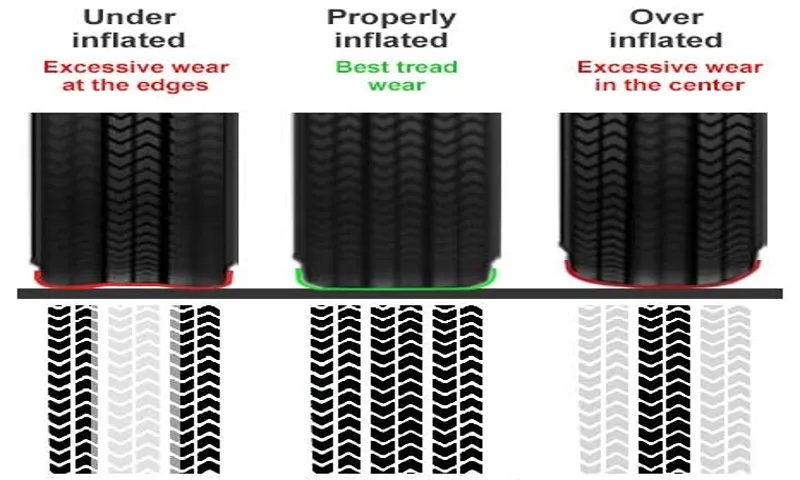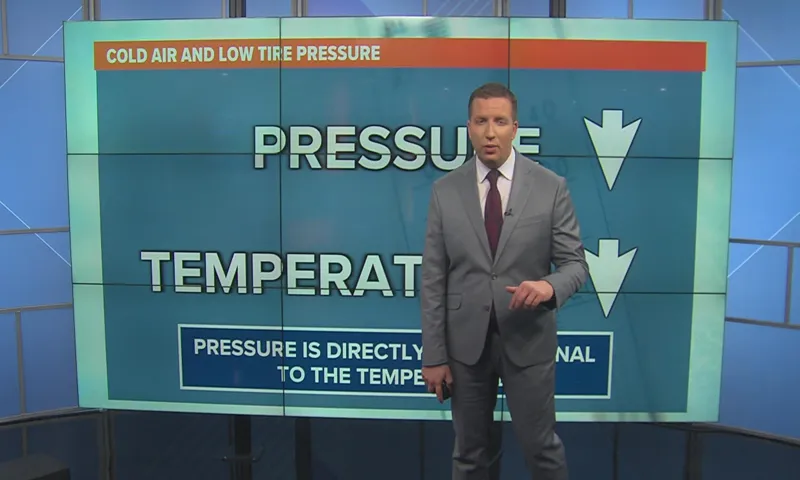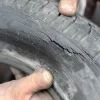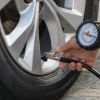Have you ever woken up to find one of your tires has inexplicably lost pressure overnight? It’s a frustrating situation that can leave you late for work or feeling uneasy about driving. Understanding the potential causes of tire pressure drops is essential for preventing future incidents and preserving the longevity of your tires. Factors like temperature changes, punctures, and tire damage can all contribute to pressure loss.
In this blog post, we’ll dive deeper into these causes and share tips for how to avoid them. So, buckle up and get ready to learn about tire pressure maintenance!
Table of Contents
Introduction
Have you ever wondered why your tire pressure suddenly drops? There are many reasons why this may happen. One common cause is a change in temperature. As the temperature drops, there is less pressure in your tires.
This is because air molecules contract when they are cold, causing the tire pressure to decrease. Another reason for a sudden drop in tire pressure could be a small puncture or leak in the tire. This leak may be so small that you cannot see it, but it can cause the pressure to slowly decrease over time.
Regularly checking your tire pressure is important to ensure your safety on the road. If you notice a sudden drop in pressure, it is important to address the issue immediately to prevent any further damage to your tire.
Explaining How Tire Pressure Works
Tire pressure is a crucial aspect of maintaining your automobile, but it is often overlooked or misunderstood. Simply put, tire pressure refers to the amount of air inside your tire, which influences its performance, safety, and longevity. The right amount of tire pressure for your vehicle is specified by the manufacturer and is typically found inside the driver’s side door or in the owner’s manual.
Proper tire pressure ensures that your tires have the required amount of grip, traction, and stability on the road, especially in emergency or slippery situations. Low tire pressure can cause tires to wear out quickly, reduce overall fuel efficiency, and increase the risk of a blowout or accident. Similarly, overinflated tires can lead to uneven tire wear, decreased stability, and reduced handling.
So, it’s essential to regularly check your tire pressure and maintain it within the recommended range to keep your car running smoothly and safely.

The Normal Pressure Range for Tires
maintain proper tire pressure Introduction: Maintaining the proper tire pressure ensures not only better handling and fuel efficiency but also increases the lifespan of your tires. However, many people often overlook the importance of monitoring tire pressure and end up either over-inflating or under-inflating their vehicle’s tires. The normal pressure range for tires varies depending on several factors like the type of vehicle, load, and tire size.
In this article, we will discuss the desired tire pressure range for different types of vehicles, how to check tire pressure, and why keeping your tires’ pressure in check is essential for a smooth and safe driving experience. Main Content: The ideal tire pressure range for a vehicle varies depending on several factors, including the vehicle’s weight, load, and tire specifications. Generally, the normal tire pressure range for most vehicles falls between 30-35 pounds per square inch (psi).
However, it’s always best to refer to the owner’s manual or the tire placard located inside the driver’s door frame for vehicle-specific tire pressure recommendations. For instance, a sportscar tire pressure recommendation may differ from that of a truck or an SUV. Apart from the vehicle’s tire pressure recommendations, you should also consider the load you put into your car.
Increased weight may make it necessary to inflate the tires slightly more than the recommended pressure. Over-inflating or under-inflating the tires can lead to uneven tread wear, poor handling, reduced fuel efficiency, and in extreme cases, tire failure. Checking your vehicle’s tire pressure is a straightforward process that can be done at home using a tire pressure gauge or at a local service station.
Start by removing the valve cap and pressing the pressure gauge onto the valve stem. The gauge will show the current tire pressure reading in psi. You can then compare the reading with the recommended pressure level and either inflate or deflate the tire as needed.
In conclusion, maintaining the proper tire pressure is crucial for not only improving your vehicle’s handling and fuel efficiency but also ensuring safety on the road. By keeping your tires correctly inflated, you can increase their lifespan, save money on fuel costs, and avoid costly tire repairs or replacements. Therefore, regularly check your vehicle’s tire pressure and always maintain the recommended tire pressure range for your vehicle for a safer and comfortable driving experience.
Causes of a Drop in Tire Pressure
If you’ve noticed a drop in your tire pressure, there are several potential causes that could be to blame. One possible culprit is a leak in the tire, which could be caused by a puncture from a sharp object or damage to the valve stem. Another possible cause could be changes in temperature or altitude, which can cause the air inside the tire to expand or contract.
Additionally, regular wear and tear can gradually cause the tire to lose pressure over time. Whatever the cause, it’s important to address the issue promptly to ensure safe and efficient driving. If you notice a drop in tire pressure, be sure to check the pressure and inflate as needed, and bring your vehicle to a trusted mechanic to diagnose and fix any underlying issues.
Temperature Changes
One of the most common reasons for a drop in tire pressure is temperature changes. Basically, as the temperature decreases, the tire pressure drops as well. So, if you have a tire that was properly inflated at 70 degrees Fahrenheit and the temperature drops to 30 degrees, your tire pressure will be lower than before.
This happens because the air molecules in the tire contract when it’s cold and expand when it’s hot. So, it’s essential to check your tire pressure during temperature changes to ensure your safety while driving. The effects of temperature changes on tire pressure are similar to how a balloon changes shape.
Have you ever noticed how a balloon appears smaller when it’s deflated compared to when it’s fully inflated? This happens because the molecules in the balloon contract when it’s deflated and expand when it’s inflated. Your car’s tires behave in the same way. So, to ensure that your tire pressure is optimal, you need to check it regularly, especially during extreme temperature changes.
This will help to prevent flats, tire blowouts, and it will also prolong the life of your tires. Remember, if your tires aren’t properly inflated, you’re putting yourself and others on the road in danger.
Slow Leaks in Tires
When it comes to maintaining your vehicle, keeping your tires properly inflated is essential not only for safety but also for optimal performance. However, it’s not uncommon for your tire pressure to drop unexpectedly due to slow leaks. Slow leaks can be caused by a variety of reasons such as punctures from road debris, damage to the tire valve, or even age and wear.
It’s important to regularly inspect your tires, including checking the tire pressure, to catch any problems early on. If you notice a drop in pressure, don’t ignore it, as this can lead to tire damage and even a blowout. By understanding the causes of slow leaks, you can prevent them from happening and keep your tires in top condition.
So, make sure to give your tires the attention they deserve for a smoother driving experience!
Damage to Tires or Wheels
“drop in tire pressure” A drop in tire pressure can be caused by various factors, including damage to tires or wheels. If you notice a sudden or gradual decrease in tire pressure, it is essential to identify the root cause and address it promptly. One of the most common reasons for a drop in tire pressure is a puncture, which could happen due to debris on the road or a sharp object piercing the tire.
Another culprit could be a damaged rim, which can cause air to leak out of the tire. Extreme temperatures, such as heatwaves or cold snaps, can also cause air to expand or contract, leading to changes in tire pressure. Additionally, aging tires can sometimes develop leaks or cracks, causing a decrease in pressure.
Regularly checking your tires and ensuring they are adequately inflated can greatly reduce the risk of a sudden drop in tire pressure and minimize the likelihood of a blowout or accident.
Preventing Tire Pressure Drops
“Why did my tire pressure drop?” is a common question that many drivers ask. Low tire pressure can be caused by a number of factors, including changes in temperature, gradual air loss, and punctures or leaks. To avoid the inconvenience of having to frequently refill your tires, it is important to take preventive measures.
Regularly checking your tire pressure can help you detect any potential drops early on and address them promptly. Additionally, properly maintaining your tires by keeping them inflated to the recommended pressure, rotating them regularly, and ensuring they are properly aligned can help prevent tire pressure drops. By taking these simple steps, you can avoid the hassle and potential safety risks associated with low tire pressure.
Regular Tire Maintenance Tips
As a car owner, it is important to ensure that your vehicle’s tires are properly maintained. One crucial aspect of maintaining your tires is preventing pressure drops. Low tire pressure can lead to decreased fuel efficiency, uneven tread wear, and even accidents.
To prevent pressure drops, make it a habit to check your tire pressure at least once a month, and before going on long road trips. You can use a tire pressure gauge to measure the pressure, and inflate the tires as needed. Additionally, keep an eye out for any leaks or damage to your tires, as these can also lead to pressure drops.
By regularly checking and maintaining your tires’ pressure, you can help ensure your safety on the road and prolong the life of your tires.
Checking Tire Pressure
Checking tire pressure regularly is important to prevent sudden drops which can cause accidents while driving. Low tire pressure can lead to poor handling, increased braking distance, and reduced fuel efficiency. It is recommended to check tire pressure at least once a month, and before long trips.
The process is simple and can be done at home using a tire pressure gauge. First, ensure the tires are cool and not warm from driving. Then, remove the valve cap and press the gauge onto the valve stem for a few seconds to get a reading.
The recommended pressure can be found in the vehicle manual or on a sticker inside the driver’s door. If the reading is low, use an air compressor to fill the tire to the recommended pressure. By checking tire pressure regularly, one can avoid potential problems on the road and save money in the long run.
Conclusion
Well, it turns out that the answer to why your tire pressure dropped is not that complicated. In fact, it’s a simple case of physics and temperature changes. As the weather gets colder, the air in your tires contracts, causing a drop in pressure.
So, the next time you notice your tire pressure dropping, don’t blame it on ghosts or gremlins; just remember the laws of thermodynamics at play and adjust your tire pressure accordingly.”
FAQs
What are some common reasons for tire pressure to drop?
Some common reasons for tire pressure to drop include changes in temperature, punctured or damaged tires, and normal wear and tear.
How often should I check my tire pressure to prevent it from dropping?
It is recommended to check your tire pressure at least once a month, or before any long road trips.
What is the ideal tire pressure for my vehicle?
The ideal tire pressure can vary depending on your vehicle make and model. Check your owner’s manual or the tire placard sticker on your vehicle’s door frame for the recommended tire pressure.
Can I drive on underinflated tires?
It is not recommended to drive on underinflated tires as it can affect your vehicle’s handling and increase the risk of a tire blowout.
How can I accurately measure my tire pressure?
You can use a tire pressure gauge to accurately measure your tire pressure. Make sure to check the pressure when the tires are cold, before driving your car.
How do I inflate my tires to the correct pressure?
Use an air compressor or visit a gas station with an air pump to inflate your tires to the recommended pressure. Do not overinflate your tires, as it can also be harmful.
Should I replace my tires if they are constantly losing pressure?
If your tire is constantly losing pressure, it may indicate a leak or puncture. It is recommended to have it inspected by a professional, and consider replacing the tire if necessary.



